Well I did say I have developed a bit of a preference for Pearl-bordered Fritillary this year. Now the time has been reached in the butterfly season when their observation period overlaps with the later flying Small Pearl-bordered Fritillary. During the past week Sussex BC announced the latter were emerging at their managed sites of Park Corner Heath and Rewell Wood. Then one of the people I met yesterday at Goring had seen some the previous day at Bentley Wood in Hants. So today seemed a good time to explore my own SPBF site of choice, Wyre Forest NNR near the towns of Bewdley and Kidderminster to the west of Birmingham.
I had only seen the third item on my 2019 butterfly agenda previously at Bentley Wood. Not being static and liking to evolve, I wanted to go somewhere new and different this time, and also away from the attention the Sussex sites will inevitably attract following on from the recent surge in interest at Rewell Wood. The ancient Oak woodland of Wyre Forest is a long-established site for both “Pearl” species, being managed co-operatively for their benefit by Butterfly Conservation (BC), the Forestry Commission and English Nature. This is achieved through coppicing, path widening, some clearing of older areas and creation of glades.
Both these images (above) were captured by me in Wyre Forest today. The NNR information boards cite the visual difference between the two butterflies as follows:
- Pearl-bordered Fritillary (above left): Mottled red and yellow underside hind wing (unh) with an obvious rectangular white pearl mark in the centre and a smaller pearl spot closer to the body. A small black dot in between these marks and a series of pearl spots around the edge of the unh wing.
- Small Pearl-bordered Fritillary (above right): Black markings on the upper side are thinner and more clearly defined than in PBF (not shown above). Those on the leading edge of the left fore-wing resemble the figures 730 (visible above). Several pearl markings in the centres of the unh wings and a much larger black dot in the centre.
But once the observer has their eye in the two species are just different on jizz. Then they are really not so difficult to tell apart at all. SPBF is not necessarily the smaller of the two. Both have a typical wingspan of 4-5 cm, and as with many butterflies the size of individual adults can depend on how much the larvae found to eat.
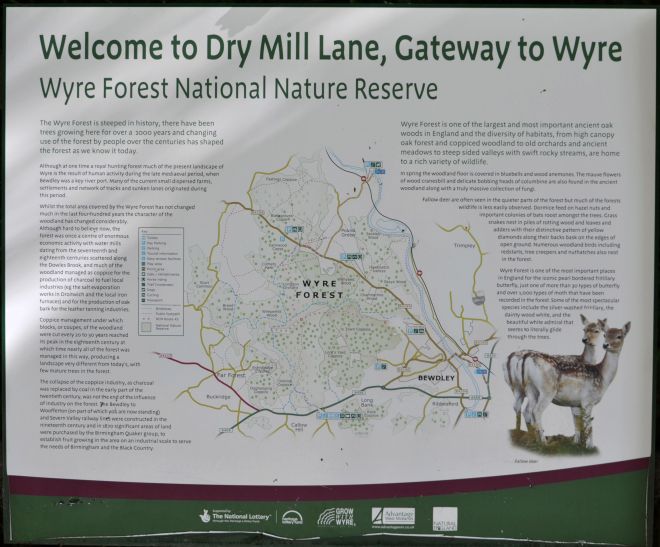
I arrived on site at 9:00 am at the Dry Mill Lane car park (SO771762) just to the north-west of Bewdley. In the medieval period that historic town was a port on the River Severn and Wyre Forest produced the charcoal that fuelled local industry. Much of the woodland was managed by rotational coppicing until coal succeeded charcoal in the early twentieth century, so in bygone times Pearl-bordered Fritillary would have thrived here.
From this entry point westward the now metalled route of a former single track railway line dissects the forest. As I walked along it the spinning coin calls of Wood Warbler were audible from either side and a first fading Pearl flew busily past. To the north terrain drops steeply to the ancient water course of Dowles Brook and its long redundant mills, down to which two permissive paths descend to foot bridges. In between those points there are several brook side meadows, and that was where a colleague from my recent Greece tour had advised me to seek out SPBF.
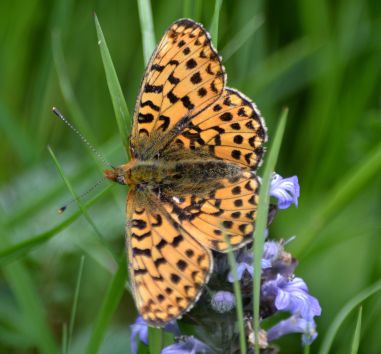
Pearl-bordered Fritillary
On my reaching this area the sun went in though faded and often worn PBF (pictured above) were indeed active in those meadows. Then at just before midday in brighter conditions a butterfly appeared that stood out by its freshness. It was a richer, chocolate brown than those others I had noted so far, and upon settling revealed the distinctive under-wing patterning of Small pearl-bordered Fritillary. But it was in a cluttered position and into the sun so these images (below) are not of the best. This was the only one I encountered today, confirming the impression I had timed my visit too early. I suppose it is logical they might emerge a little later here than further south in Sussex and Hampshire.
I was then distracted by a perfectly posed PBF and the opportunity to acquire the good under-wing pictures that had eluded me in three other locations this season was not to be missed. It does not get better than what then ensued, especially since the images below are completely natural and as I found the butterfly, without wrangling or props. I had gone into the 2019 season wishing for such results and have possibly now succeeded.
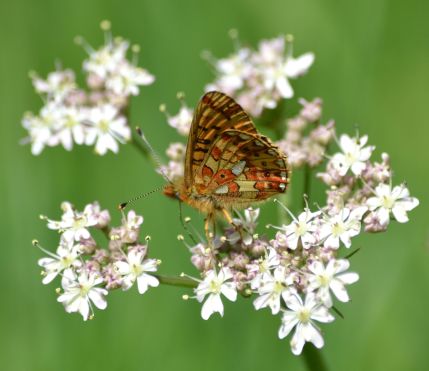
Pearl-bordered Fritillary (all pictures)
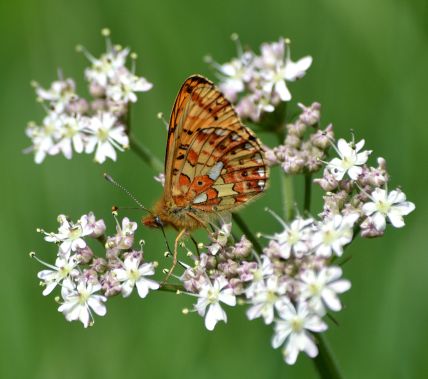
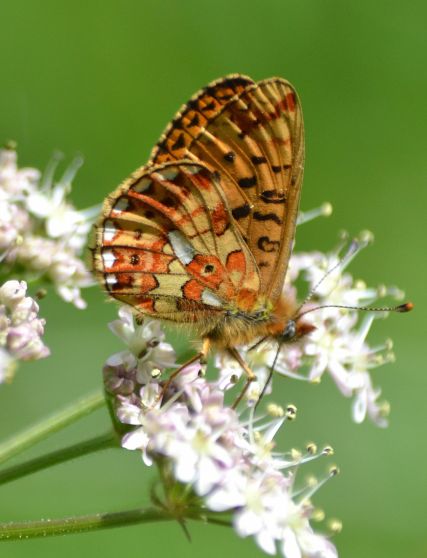
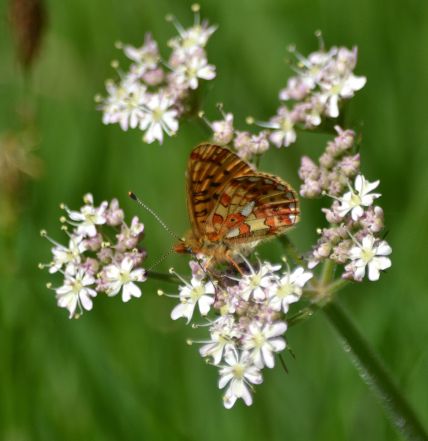
Yes I rather like these images and the visit will for ever be memorable for the encounter that produced them. This was true communion of the purest quality. I was helped by the butterfly being completely unconcerned by my presence. I will admit to taking away grass stems from around the flowery perch, at which my subject did not flinch. So I went in point blank with my macro lens and still the little gem wasn’t the slightest bit bothered. Even when I grasped the flower stem to attempt bizarrely angled images the Pearl just carried on nectaring without a care in the world. Such an amazing degree of tolerance is something I have only experienced previously with Black Hairstreak.
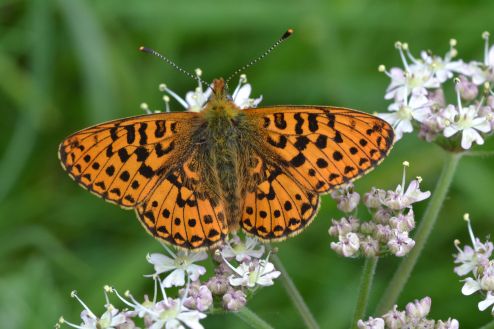
Pearl-bordered Fritillary (above and below)
Once I had done this small and surprisingly pristine individual’s under-wings justice it as obligingly opened up and so proceeded to offer premium top side studies as well (above). It was then time to relocate the Small Pearl but I was not successful and found no others. So when conditions became more overcast again in the early afternoon I left with the intention of giving my newest quest a little longer to start flying and then re-visiting.
More PBF (pictured below) were active along the railway line path as I walked back, which is where my site briefing had led me to expect to find them. Some of these were rather small individuals as well, underlining that size is not an indicator when distinguishing the two target butterflies observed today.
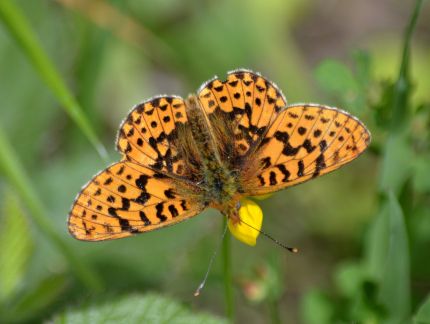
Pearl-bordered Fritillary
On my second visit a week later on 1st June Small Pearl-bordered Fritillary were my priority, and indeed two (pictured below) stood out amongst the remaining PBF that were yet on the wing as I walked out along the old railway line. My spirits were in need of refreshment after a disappointing week in other respects, and I was looking to these evocative surroundings of Wyre Forest to provide it.
Upon reaching the meadows along Dowles Brook more SPBF were flying though not many. This time I walked a little further upstream into a new area for me that proved to be the most productive so far. But the three or more Small Pearls there were always flighty and intent on harassing one another so acquiring the pictures I desired was always difficult. Sunlight was at best hazy throughout my stay and though individuals could be found basking at intervals, I expect they were spending much of their time tucked away low in cover like the one in the right hand picture below.
Getting close to these butterflies or seeking more out would have involved wading into the meadow habitat rather more than I prefer to do. The meadows also appeared to hold quite a good selection of moths, which is an insect group I have little knowledge of and try not to become distracted by in the field. Occasionally though something grabs my attention and a number of Chimney Sweeper (pictured below) piqued my interest now. This fairly common day flying moth is more widespread in northern Britain than the south, occurring in the former in damp, grassy habitats such as this.
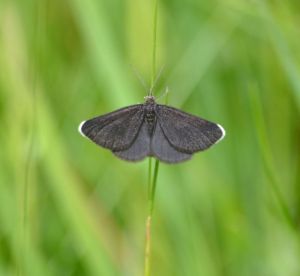
Chimney Sweeper
The Small Pearl tally from this location was disappointing and so I decided to pay some more attention to the railway line path on my way back to the car. I came across no more SPBF this time, but there remained one further photogenic encounter with a still fresh and seemingly fearless Pearl-bordered Fritillary. This produced another good sequence of under-wing studies as it nectared on the track-side flowers. And so my dealings with this duo of scarce and appealing little butterflies across five different locations were over for the season, and it had all been on the whole enjoyable.
Wyre Forest, one of England’s largest and most diverse ancient oak woodlands, is undeniably a superb place to enjoy walking in and one that though much visited retains a wild and untamed character. The NNR holds more than 30 different butterfly species as well as good breeding populations of Wood Warbler, Common Redstart and Pied Flycatcher. Of those three birds the first-named was the most obvious and frequent, especially on the wooded slopes between the old railway line and Dowles Brook. So I might well return here in the future to pay proper attention to summer visiting birds as well.
After leaving the NNR I spent a little time by the riverside in Bewdley and it was plain that a lot of people had the same idea. The attractive and atmospheric town centre is a conservation area that remains little altered since the 18th century, and offers a wide choice of pubs, eating places and music venues; as well as parks, a museum and the Severn Valley Railway. All this makes it a popular place for a day out and I soaked up the ambience for a while and took some pictures before heading home.
















